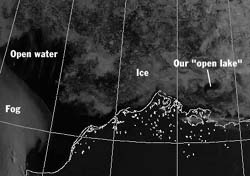|
|
 |
Daily Update
Calendar
Dispatch 15 - July 29, 2002
By C.A. Linder
Weather conditions: clear skies, calm winds and seas, air temperature 37° F.
Bird’s Eye View
What happened to all of the ice? This morning on my way to breakfast I peeped out of one of the portholes, and for a second I thought we were back in Dutch Harbor! There was nothing but blue water in every direction. John Kemp and Bob Pickart were all smiles as we steamed merrily along confirming the depth for the second Beaufort slope WHOI mooring. As soon as Bob was satisfied with our position, John Kemp led the second WHOI mooring deployment. Instead of shivering in heavy coveralls and knit caps, the deck crew rolled up their sleeves and applied the sunscreen. The mooring was in the water in no time at all. We also deployed one of the two Acoustic Recording Packages (ARPs) today. This is a very small moored instrument designed to listen to and store whale calls. We are putting in two of these instruments for scientists Sue Moore and John Hildebrand, who are studying the migration patterns of bowhead whales and other marine mammals. This data will be coordinated with the environmental data that Bob Pickart’s moorings are collecting.
 |
 |
| A visual satellite
image from this morning clearly shows our “open lake”. |
| Click
to enlarge |
So what has changed since yesterday, when we were fending ice away from the mooring and cursing the bone-chilling mist? David Leech helped me out by showing me some satellite images from a National Weather Service website. Since it was a beautiful cloudless day, a visual satellite image provided a clear view of the ice over the entire western Arctic. Sure enough, a huge “open lake” was clearly visible on the satellite image, and we were right in the middle of it. We are still pondering what caused this open water area and its interesting swirl-like shape. We are hoping to be able to take advantage of these perfect conditions for the next few days, enough time to finish deploying the WHOI mooring array and complete our CTD survey.
Since the weather was the clearest it has been in days, the aviators
also took advantage of the conditions by making a short trip in one
of the Polar Star’s HH-65A Dolphin helicopters. Pilots
Bruce Decker and Scott Weaver and aircrewman Chris Murray were kind
enough to let me ride along and take pictures. Our mission was to
pick up a small package of supplies for our nutrient analyzer from
the Coast Guard icebreaker Healy, which was working in the
ice to our north on the same Shelf-Basin
Interactions (SBI) project. It’s one thing to see the ice
up close, and another entirely to see it from the air. I instantly
gained a deeper appreciation for the great variety in ice conditions
that we have seen over the past few days. Within minutes of departing,
we left our open water pocket behind and were cruising over endless
fields of ice. I saw pressure ridges, which look like fat stitches
on the ice. They form when large ice sheets slam together. I saw fields
of bergy bits and growlers, the small ice chunks that make science
operations so difficult. I also saw the whole range of ice colors,
from brown sediment- and algae-laden ice to the pure white of first-year
ice to the blue aquamarine of multi-year ice. If you looked closely,
you could see intricate patterns in the melt pools below, things you
could never appreciate from sea level.
After fifteen short minutes in the air, Scott Weaver spotted the Healy
on the horizon. It was really remarkable seeing another ship. Although
we knew the Healy was working in the vicinity, we have never
seen her or another vessel since we left port. After circling a few
times, we hovered over the bow and Chris Murray opened the door. Using
the helicopter’s rescue winch, he sent down a small duffel bag
to the waiting crewmen of the Healy. They grabbed the bag and
put our package inside; we pulled it up and off we went. The real
treat for me was seeing our ship from above as we returned. I had
never seen the ship from the outside (on our arrival I was in the
far back seat), and to finally see it after fifteen days of living
aboard was incredible. When we touched down on the deck it felt like
we had never left - time flies when you’re having fun!
 Previous Dispatch
Next Dispatch Previous Dispatch
Next Dispatch

Back to Calendar
|
|




